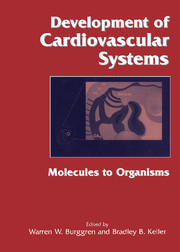Book contents
- Frontmatter
- Contents
- List of contributors
- Foreword by Constance Weinstein
- Introduction: Why study cardiovascular development?
- Part I Molecular, cellular, and integrative mechanisms determining cardiovascular development
- Part II Species diversity in cardiovascular development
- Part III Environment and disease in cardiovascular development
- 17 Oxygen, temperature, and pH influences on the development of nonmammalian embryos and larvae
- 18 Modeling gas exchange in embryos, larvae, and fetuses
- 19 Principles of abnormal cardiac development
- 20 In utero and postnatal interventions for congenital cardiovascular malformations
- 21 Applying the science of cardiovascular development to congenital cardiovascular malformations
- Epilogue: Future directions in developmental cardiovascular sciences
- References
- Systematic index
- Subject index
21 - Applying the science of cardiovascular development to congenital cardiovascular malformations
from Part III - Environment and disease in cardiovascular development
Published online by Cambridge University Press: 10 May 2010
- Frontmatter
- Contents
- List of contributors
- Foreword by Constance Weinstein
- Introduction: Why study cardiovascular development?
- Part I Molecular, cellular, and integrative mechanisms determining cardiovascular development
- Part II Species diversity in cardiovascular development
- Part III Environment and disease in cardiovascular development
- 17 Oxygen, temperature, and pH influences on the development of nonmammalian embryos and larvae
- 18 Modeling gas exchange in embryos, larvae, and fetuses
- 19 Principles of abnormal cardiac development
- 20 In utero and postnatal interventions for congenital cardiovascular malformations
- 21 Applying the science of cardiovascular development to congenital cardiovascular malformations
- Epilogue: Future directions in developmental cardiovascular sciences
- References
- Systematic index
- Subject index
Summary
Introduction
Every adult once had the heart of a child and before that the heart of a fetus and an embryo. This fact delineates the continuum from primary cardiovascular development through maturity and senescence. Although studies of cardiovascular development date back to Aristotle, advances over the last two decades are now defining the processes that link pathogenesis to the prevention of human disease (Neill & Clark, 1995; Clark, Markwald, & Takao, 1995).
In this century, the enterprise of children's cardiovascular health has broadened from the medical management of acute rheumatic fever to the surgical repair of congenital cardiovascular malformations (Moller et al., 1993). In spite of surgical advances, cardiovascular malformations, with a prevalence of 8 per 1000 live births, are the leading cause of infant mortality from congenital defects (Clark, 1994). As other causes of infant morbidity and mortality have yielded to therapy, teams of clinical and basic-science investigators are searching for ways to reduce the prevalence of cardiac defects.
Now, we are in an era reexamining cardiac embryology and defining the etiology and pathogenesis of cardiac disease (Clark, 1986). Advances in molecular and cellular biology have provided tools for the diagnosis of cardiac defects such as hypertrophic cardiomyopathy, Marfan syndrome, and familial arrhythmias. These gains will eventually lead to the prevention of heart disease (Deitz & Pyeritz, 1995). Thus, our management of congenital defects and adult-onset cardiovascular diseases will benefit from this expanded knowledge base regarding cardiovascular development.
- Type
- Chapter
- Information
- Development of Cardiovascular SystemsMolecules to Organisms, pp. 281 - 284Publisher: Cambridge University PressPrint publication year: 1998



